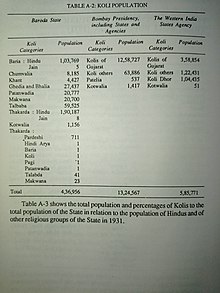Baria,[1] or Baraiya,[2] Bareeya[3] and Bariya[4] is a clan (Gotra) of the Koli caste found in the Indian State of Gujarat[5] and Dadra and Nagar Haveli and Daman and Diu.[6] the Devgad Baria was their Stronghold or given their name to Baria State in Gujarat.[7] according to the historian Y.V.S Nath, the ruling royal family of Baria State is original Koli by caste but later they claimed to be of Rajput origin to be in high status among other Princely States.[8]
| Baria Koli બારિયા કોલી | |
|---|---|
| Clan of Koli caste | |
 Koli population in Gujarat in 1931 including Baria Kolis | |
| Ethnicity | Koli people |
| Location | Gujarat |
| Religion | |
| Surnames | |
According to the census records of 1931, there were 1,03,769 Hindu Baria Kolis and 5 Baria Kolis were converted to Jain religion in the Baroda State of Gaekwars.[9]
Origin edit
The Baria Kolis got their name from the Devgadh Baria of Gujarat and it was their Stronghold as well as they were lawless and turbulent people.[10]
Piracy edit
Historically, the Baria Kolis were well known pirates of Gujarat and the Piram island of Gujarat was stronghold of Baria Koli pirates but later they were defeated by Mokhadaji Gohil in 1325.[11]
Rawal Bhavsinhji of Bhavnagar died in 1764, leaving behind him five sons, and the eldest of and these, Akherajji I, succeeded as Ruler of the State. At this juncture the fort of Talaja was in the hands of Baria Koli pirates, a ment lawless band of pirates who infested the western littoral from Cambay to the Indus. Their unjust exactions pressed so heavily upon merchants in that locality that the large trade previously carried on was almost entirely ruined, even British ships falling ment then sent troops, which were assisted by Rawal Akherajji and his army, and it was their combined forces which captured the stronghold of Talaja and defeated the Baria clan of Koli pirates.[12]
History edit
During the British Raj in Gujarat, The Baria Kolis were holders of Vanta lands (private estates).[13] the Bariya Kolis were formerly known as Bandits because of their anti-social activities but later settled as agriculturist in villages.[4]
Around 1950, Kolis of Baria clan joined the Gujarat Kshatriya Sabha which was started by Koli elite Natwarsinh Solanki for upliftment of Koli society.[14] after joining the Sabha, Baria Kolis were not in conflicts against Rajputs but Kolis of Saurashtra didn't join the Sabha because they thought that 'Patidar wasn't their enemy and they didn't need to be Rajputs to be called as Kshatriya'.[3]
See also edit
References edit
- ^ Enthoven, Reginald Edward (1990). The Tribes and Castes of Bombay. New Delhi, India: Asian Educational Services. p. 65. ISBN 978-81-206-0630-2.
{{cite book}}: CS1 maint: date and year (link) - ^ Yājñika, Acyuta; Sheth, Suchitra (2005). The Shaping of Modern Gujarat: Plurality, Hindutva, and Beyond. New Delhi, India: Penguin Books India. p. 304. ISBN 978-0-14-400038-8.
{{cite book}}: CS1 maint: date and year (link) - ^ a b Dominance and State Power in Modern India: Decline of a Social Order. New Delhi, India: Oxford University Press. 1989. p. 104. ISBN 978-0-19-562098-6.
{{cite book}}: CS1 maint: date and year (link) - ^ a b Plunkett, Hugh Sheridan (1972). Leadership and Social Change in a District of Rajasthan, India. New Delhi, India: University of California, Berkeley. p. 191.
{{cite book}}: CS1 maint: date and year (link) - ^ "A community called Koli - Indian Express". archive.indianexpress.com. Retrieved 2022-04-01.
- ^ Gopal, Krishna (2003). Fairs and Festivals of India: Chhattisgarh, Dadra and Nagar Haveli, Daman and Diu, Goa, Gujarat, Madhya Pradesh, Maharashtra. New Delhi, India: Gyan Publishing House. p. 35. ISBN 978-81-212-0811-6.
{{cite book}}: CS1 maint: date and year (link) - ^ Desai, Anjali H. (2007). India Guide Gujarat. New Delhi, India: India Guide Publications. p. 184. ISBN 978-0-9789517-0-2.
{{cite book}}: CS1 maint: date and year (link) - ^ Nath, Y. V. S. (1960). Bhils of Ratanmal: An Analysis of the Social Structure of a Western Indian Community. New Delhi, India: Maharaja Sayajirao University of Baroda. pp. 65: presence in these regions, by explaining that they came in the wake of the founders of the present ruling houses of Bariya State and other estates in the area. The latter however claim to be Rajputs today, though the local traditions give them a Koli extraction." Till recently, most of the thakurdari and ankadi rights in these States were held by Bariya Kolis. Some of them even claim kinship with the Rulers of Baria and the Thakurs of Ratanmal.
{{cite book}}: CS1 maint: date and year (link) - ^ Lobo, Lancy (1995). The Thakors of North Gujarat: A Caste in the Village and the Region. New Delhi, India: Hindustan Publishing Corporation. p. 188. ISBN 978-81-7075-035-2.
{{cite book}}: CS1 maint: date and year (link) - ^ Shah, A. M.; Desai, Ishwarlal Pragji (1988). Division and Hierarchy: An Overview of Caste in Gujarat. New Delhi, India: Hindustan Publishing Corporation. p. 7. ISBN 978-81-7075-008-6.
{{cite book}}: CS1 maint: date and year (link) - ^ Singhji, Virbhadra (1994). The Rajputs of Saurashtra. New Delhi, India: Popular Prakashan. p. 39. ISBN 978-81-7154-546-9.
{{cite book}}: CS1 maint: date and year (link) - ^ Bond, J. W.; Wright, Arnold (2006). Indian States: A Biographical, Historical, and Administrative Survey. New Delhi, India: Asian Educational Services. pp. 371–376. ISBN 978-81-206-1965-4.
{{cite book}}: CS1 maint: date and year (link) - ^ Clark, Alice Whitcomb (1979). Central Gujarat in the Nineteenth Century: The Integration of an Agrarian System. New Delhi, India: University of Wisconsin--Madison. pp. 354–355.
{{cite book}}: CS1 maint: date and year (link) - ^ Ghosh, Buddhadeb; Kumar, Girish (2003). State Politics and Panchayats in India. New Delhi, India: Manohar Publishers & Distributors. p. 95. ISBN 978-81-7304-487-8.
{{cite book}}: CS1 maint: date and year (link)